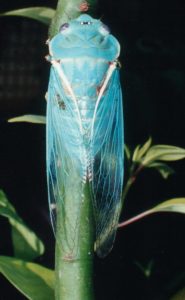Blue cicadas. Did you know they exist? They do… at least in Australia.
What’s That Bug recently posted a photo of a blue Bladder Cicada from Australia (Cystosoma saundersii). It’s a great find. Cystosoma saundersii are typically green.
Then there is the Blue Moon blue colored morph of Cyclochila australasiae:

Photo by David Emery
Cyclochila australasiae come in many colors, but the most common color is green. “Blue Moon” is a good nickname for these cicadas because they are rare and only found, idiomatically speaking, “once in a Blue Moon”.
So, why are some cicadas blue, when their species is typically green? Here is a quote from the paper Blue, red, and yellow insects by B. G. BENNETT, Entomology Division, DSIR, Private Bag, Auckland, New Zealand:
The colours of insects are often due to a complex mixture of pigments, some of which
are concentrated from their diet. These are carotenoids, flavonoids, and anthraquinones, and some are porphyrins made from the breakdown of plant chlorophyll. Insectoverdin is a common green pigment produced by a mixture of blue and yellow compounds. The blue is tetrapyrrole, but sometimes an anthocyanin, and the yellow is a carotenoid.
Blue + yellow = green. If the yellow is missing, you get a blue cicada. I heard that, at least in the case of the Cyclochila australasiae, the blue cicadas are typically females. Perhaps something related to genetics or behavior of the females leads to an inability to process the caroteniods ingested along with their diet (tree fluids). I’m not sure, but it’s a topic that fascinates me, so I’ll continue to look into it.
6 replies on “Blue Cicadas”
I saw a blue cicada last summer (2020) in Maryland, USA. I didn’t know they was so rare.
I found one in Oregon, USA as well!
Are we able to breed cicadas and introduce them into my yard? Just wondering that’s all
You’ll need trees, and enough male and female cicadas to mate, but it is possible.
Yes, blue for green grocers is the absence of yellow pigment and easily spotted by predators, including my 4-yr old daughter who found this one. She has found 2 “blue moons”, one male and the female above.
fascinating ! and what a beautiful color . not too well camouflage though , so maybe that’s why they’re so rare . I’d be interested to know what else you find out about this topic !